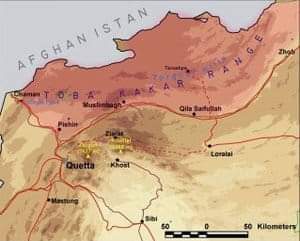Arab conquest of Kaikan
| Arab conquest of Kaikan | |||||||||
|---|---|---|---|---|---|---|---|---|---|
| Part of Umayyad conquest of Sindh | |||||||||
 Kaikan mountain ranges | |||||||||
| |||||||||
| Belligerents | |||||||||
|
| Jats of Kaikan | ||||||||
| Commanders and leaders | |||||||||
|
| Unknown | ||||||||
| Casualties and losses | |||||||||
| Unknown | Unknown | ||||||||
The Arab conquest of Kaikan (alternatively Kikan, Kiknan, Qaiqan or Qayqan) was a military campaign by the Rashidun and Umayyad Caliphates aganist the Jats of Kaikan, in present-day Pakistan.[1][not in citation given] The Kingdom of Kaikan faced several invasions from the caliphate. During the reign of the Khalifa Al-Mutasim, the Arabs annexed this region successfully after defeating the Jats.
History[edit]
The first raid is noted by the historians Al-Baladhuri, Ibn Sa'd and Khalifah ibn Khayyat to have taken place in 658 CE. Kaikan was known as al-Qiqan to them and located near Quetta. Harith ibn Murrah al-Abdi and Sayfi ibn Fil al-Shaybani had participated in this raid.[2][misquoted]
During the fourth Caliph Ali two expeditions were sent over Sind, one in A. H 38 and the other in A. H. 40 under the leadership of Härıs and Taghar or saghar respectively, and both of them met with success. R. C. Majumdar quotes the version of Al-Baladhuri that the leader of the Muslim host was killed together with all but a few of his followers, but he (Al-Baladhuri) is actually referring to Härıs's second expedition which was led, not in the time of Ali, but in the Caliphate of Mu'awiya I, in 42 A. H. (663 CE). Therefore it can not be said that the expeditions sent in the time of Ali were met with disastrous results.[3] Harith along with his followers was killed in this battle in the year 42 AH (663 CE).[4] This was a huge blow for the Caliph, and so, for the next twenty years, every successive Caliph made Kaikan a special target for conquest and sent as many as six expeditions, five of which failed to make any permanent impact in Sindh.[5]
Emir Abd Allah ibn Amir, or the Caliph Mu'awiya I himself, is said to have sent Abdallah ibn Sawwar al-Abdi to Sindh. He is said to have fought in Kaikan and captured some spoils, but is said to have been killed by the Turks.[6]Template:Undefined
Ziyad ibn Abihi (also known as Ziyad ibn Abu-Sufian), during the reign of Mu'awiya I, appointed Rashid ibn Omar al-Judaidi, a member of the Azd tribe, to the frontiers of Sindh. al-Judaidi was the first Arab to win a battle against Kaikan, but was killed by the Meds.[5] Ziyad then appointed al-Manzar (also spelt al-Mundhir) ibn al-Jarud al-Abdi (also known as Abu-l-Ash’as) to Sindh. al-Manzar is said to have conquered Kaikan.[citation needed]
When Muhammad bin Qasim (694 - 715) invaded Sindh, Kaikan was the possession of the Jats. The country of Kaikan was triangulated to be to the south-east of Afghanistan, and was decisively conquered from the Jats by the Arab general Imran bin Musa al Barmaki (son of Musa ibn Yahya) during the reign of the Caliph Al-Mutasim-bi-llah (833-881). During his reign, another expedition was sent against the Jats who had seized the roads to Hajar. They were overcome after a bloody conflict lasting twenty five days.[7]
Aftermath[edit]
The Arabs called the Jats (Zutt) of Qiqan the Qiqaniyya. Many Qiqani Zutts had been taken captive between 659 and 664 by Abd Allah bin Sawwar al-Abdi to Iraq, who was appointed as the governor of the regions surrounding Sindh.[8] al-Abdi was himself killed in one of the wars against the Qiqani Zutts in 667 and Qiqan was re-conquered by them.[8] Always armed with arrows, whether cavalry or infantry, these Zutt Qayqaniyya units were considered the master archers of the caliphate, and acted as an auxiliary group for the shurta police.[8] The Qiqaniyya as well as the Bukhariyya, an Iranian unit of soldiers, were sent to suppress the revolt of Zayd ibn Ali in 740 by the Umayyad Caliphate.[9]
See also[edit]
References[edit]
- ↑ Barve, Shashikant V. (1995). Introduction to Classical Arabic: A Contribution to Islamic and Oriental Studies. S.V. Barve. p. 451. Search this book on

- ↑ Maclean, Derryl N. (1989). Religion and society in Arab Sind. Leiden, Netherlands / New York / København: E.J. Brill. p. 126. ISBN 978-90-04-08551-0. Search this book on

- ↑ Digital Library Of India, Cdac Noida (1966). Journal Of The Oriental Institute Vol-xvi No-2 (1966). pp. 186–187. Search this book on

- ↑ D. Rao, Vasant; Gokhale, Balkrishna Govind; D'Souza, A. L. (1966). Ancient Indian History and Culture. A.R. Sheth. p. 323. Search this book on

- ↑ 5.0 5.1 Islam, Arshad (1990). History of Sindh During The Pre-Mughal Period (PhD Thesis) (PDF). Aligarh: core.ac.uk. Search this book on

- ↑ al-Hamawi, Yaqut. Mu'jam al-Buldan [Dictionary of Countries] (in Arabic). p. 423.CS1 maint: Unrecognized language (link) Search this book on

- ↑ Barve, Shashikant V. (1995). Introduction to Classical Arabic: A Contribution to Islamic and Oriental Studies. S.V. Barve. p. 451. Search this book on

- ↑ 8.0 8.1 8.2 Zakeri 1995, p. 195.
- ↑ Zakeri 1995, p. 196.
Bibliography[edit]
- Zakeri, Mohsen (1995). Sāsānid Soldiers in Early Muslim Society: The Origins of ʻAyyārān and Futuwwa. Otto Harrassowitz Verlag. ISBN 978-3-447-03652-8. Search this book on

- Al-Baladhuri (1924). Kitab Futuh Al-buldan: The Origins Of The Islamic State Vol 2. Translated by Murgotten, Francis Clark. New York: Columbia University. Search this book on

This article "Arab conquest of Kaikan" is from Wikipedia. The list of its authors can be seen in its historical and/or the page Edithistory:Arab conquest of Kaikan. Articles copied from Draft Namespace on Wikipedia could be seen on the Draft Namespace of Wikipedia and not main one.
